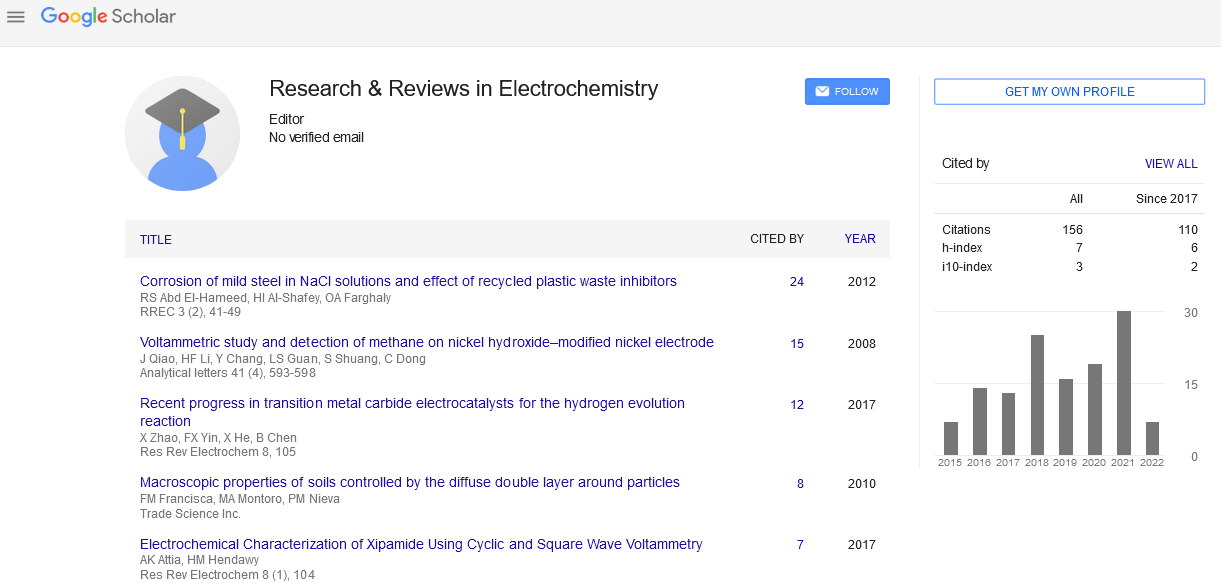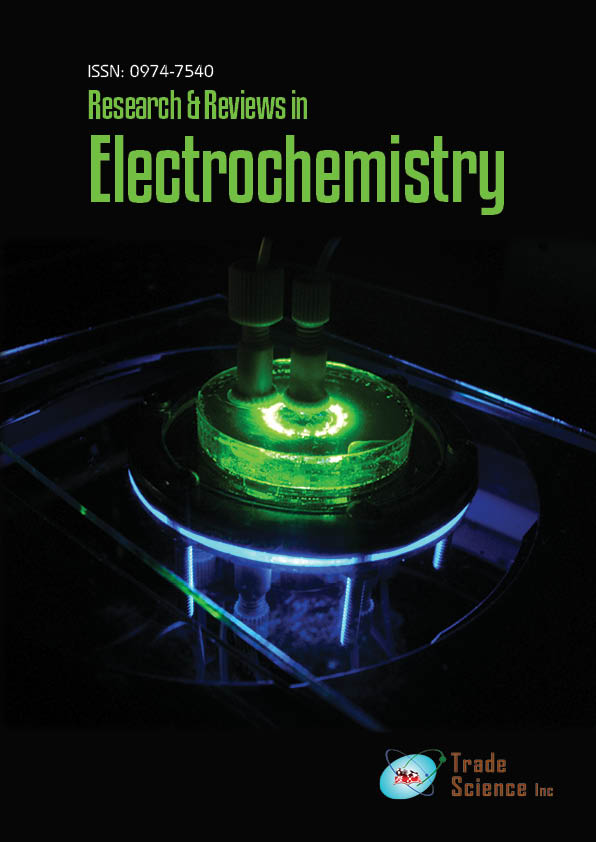Short commentary
, Volume: 12( 2) DOI: 10.37532/0974-7540.22.12.2.239Bloodstain Degradation and Time Since Deposition Estimation Using Electrochemistry
- *Correspondence:
- Amber WilliamsEditorial Office, Research and Reviews in Electrochemistry, UK; E-mail: electro.med@scholarres.org
Received: 4-March-2022; Manuscript No. tsrre-22-66677; Editor Assigned: 18-March-2022; PreQC No. tsrre-22-66677 (PQ); Reviewed: 26- March-2022; QC No. tsrre-22-66677 (Q); Revised: 28-March-2022; Manuscript No. tsrre-22-66677 (R); Published: 30-March-2022, DOI No. 10.37532/0974-7540.22.12.2.239
Citation:Williams A. Bloodstain Degradation and the Time Since Deposition Estimation Using Electrochemistry. Res Rev Electrochem. 2022;12(2):239.
Abstract
Blood is an essential sort of forensic evidence because it may be used to identify sources, perform toxicological investigations, and evaluate bloodstain patterns. Determining the time of bloodshed, often known as the bloodstain's time since deposition (TSD), has significant consequences for crime scene investigation. In this paper, we use differential pulse and hydrodynamic voltammetry to monitor the progressive oxidative changes and electron-transfer reactions of haemoglobin (Hb) that occur in decaying bloodstains. Bloodstains were seen during a two-week period in five distinct temperature conditions. According to linear mixed models derived from Differential Pulse Voltammograms (DPV), 7 out of 27 variables linked to the redox processes connected with the blood film were substantially correlated with time (p 0.033). All of the linked variables were related to the binding of oxygen to haemoglobin or the oxidation of haemoglobin breakdown products inside the film. When haemoglobin is aged on an electrode surface, it keeps its catalytic activity for oxygen reduction, with a shift to higher peroxide generation as the age increases. When the biological replication is treated as a random effect and peak area ratios are incorporated in the model, time series models improve. Interestingly, independent of temperature setting, we detected a significant shift in redox response at the 96-h time point (p 0.043) using linear mixed models. Overall, we provide early support for DPV as a strategy for estimating TSD in bloodstains.
Keywords
Haemoglobin breakdown; Differential pulse voltammograms; Hydrodynamic
Introduction
Blood samples and blood-stained evidence continue to be among the most commonly obtained substances by forensic specialists. Because of their specific physical, chemical, and biological qualities, bloodstains seen at crime scenes and blood samples taken for investigation purposes have great evidential value. Whole blood includes a number of biomolecules of relevance to forensic and medical specialists, such as DNA and RNA, Haemoglobin (Hb), and medications and their metabolites. Forensic investigators, for example, gather blood evidence for source identification using DNA profiling, and forensic toxicologists frequently examine blood samples for the presence of illegal or impaired substances, poisons, and prescription pharmaceuticals. Bloodstain pattern analysis may also be used to certain types of bloodstains and bloodstain patterns seen at crime scenes.
Estimating the Time Since Deposition (TSD) of evidence is a primary focus of forensic research. The unity of place and time is a fundamental goal in evidence analysis across the TSD literature. When an individual or item is linked to a location within a specific time frame, the chain of events becomes more comprehensive. This material is useful for law enforcement and trial testimony. Paints/inks, fingerprints, and diverse biological evidence, including blood, are among the forensically important samples researched for TSD applications.
Blood evidence provides detectives with a variety of information, but identifying the period of slaughter remains a difficult question to solve. For around 20 years, researchers have been studying methods to determine the TSD of a bloodstain, with an emphasis on studies that quantify Hb and cellular component degradation using spectrometric techniques, as well as changes in DNA and/or RNA. However, there is no widely acknowledged method for measuring the TSD of a bloodstain at the moment, and previously proposed approaches are still being refined for temporal resolution and extended age correlation. The diversity in the blood supply and external factors such as temperature, humidity, and sunshine contribute significantly to the complexity.
Hb remains the major biomolecule of interest for TSD estimations of bloodstains because it accounts for around 90% of the dry weight of red blood cells (RBCs). In previous forensic research projects, the oxidative alterations of Hb, notably the core iron atom, showed interesting relationships with time. Hb exists in three states in a healthy person: oxygenated Hb (oxyHb), deoxyHb, and methemoglobin (metHb). When the main ligand, oxygen (O2), is reversibly attached to the central iron atom in the protoporphyrin ring, this is referred to as OxyHb. Whether iron is in its ferrous (Fe2+) or ferric (Fe3+) oxidation state during this configuration is debatable, with the bulk of research favouring the ferrous state. The central iron atom is brought into plane with the protoporphyrin ring upon O2 binding, adopting a low spin state. The lack of O2 in the Hb-protein complex indicates the presence of deoxyHb. The core iron atom is in a ferrous state in this condition and resides 0.4 outside the protoporphyrin ring to shield itself from oxidative attack. In a healthy person, these two states account for the vast majority of Hb. Despite its stability, oxyHb is oxidised to metHb at a rate of around 3% every day. During this process, the bound O2 is reduced to water, while Hb is oxidised from Fe2+ to Fe3+. Water is the main ligand in its Fe3+ state, and the Hb protein is unable to transport O2. MetHb concentrations in a healthy person are maintained by internal reduction processes such as glutathione peroxidase, cytochrome b5 oxidoreductase, and methemoglobin reductase. These systems successfully recycle metHb to deoxyHb, where it can once again transport O2. Problems with these internal reduction processes are the root causes of blood disorders such as anaemia and thalassemia. Similar oxidative alterations to Hb occur in a bloodstain over time, with additional degradation mechanisms to cellular components.
When a bloodstain forms under ex vivo settings, the available deoxyHb is instantly saturated by ambient O2 and transformed to oxyHb. This quick reaction is caused by free heme's strong attraction for an O2 molecule. From here, the oxyHb continues to slowly oxidise to metHb. Because of denaturation, the enzymes responsible for converting metHb back to deoxyHb are no longer accessible. Following this, the protein structure undergoes reversible and irreversible modifications, culminating in the creation of hemi- and hemochrome (HC). These species are termed by the iron's oxidation state, either ferric (hemichrome-Fe3+) or ferrous (hemochrome-Fe2+). Environmental pressures cause additional breakdown of the bloodstain over time, resulting in cellular damage and hemolysis. Forensic researchers are interested in the ex vivo Hb degradation process because it provides insight on TSD estimate changes that may be detected utilising analytical methods. Electrochemical technologies, such as Differential Pulse Voltammetry (DPV), provide sensitive analysis with small sample quantities and few sample preparation procedures. Forensic electrochemistry has made tremendous progress in the detection and quantification of forensic evidence such as explosives, gunshot residue, alcohol intake, and illegal substances. Electrochemical methods have been used to blood samples for medical research objectives and have shown relevance for identifying blood-related disorders via Hb species differences. Similar autoxidative and cell-damaging reactions observed in the body can be attributed to the natural breakdown of Hb and blood in the environment. The bloodstain TSD literature is a current and essential field in forensic chemistry because being able to offer a time-stamp to when a bloodstain was created at a crime scene has major medico-legal ramifications. Using electrochemical techniques to investigate the redox chemistry of decaying bloodstains complements existing approaches for estimating TSD and may facilitate the use of several methodologies to solve these temporal concerns.

